Some people might question whether electricity is the most pressing need for desperately poor villages that lack almost everything, from access to medicine to decent education to a chance to earn any sort of income. But Gyanesh Pandey, co-founder and CEO of Husk Power Systems, has never seen it that way. For him, access to electricity is just the first step in realizing a much broader vision for rural development. In addition to which, electricity itself brings huge benefits, as he explained to Caroline Hartnell.
“For us the bottom line is development benefits. We are not just sellersof electricity; we are a powerhouse of rural development.”
How did the idea of Husk Power first come about?
I come from a village without electricity. When I left school I went to the US – I just wanted to get away from India. At some point I realized that there is no getting away: you are what you are, and I began to wonder what would be the best way to do something for rural development. Over the next ten years or so, I formed a vision that encompasses doing some simple work in five different areas.
My friend Ratnesh Yadav is very environmentally conscious and concerned about rural areas. We decided to start by doing something on energy, and it took us a few years to come up with Husk. Then Manoj Sinha, who is very dynamic and business-oriented, came in, and that’s basically how it happened.
How do you see access to electricity relating to other broader development goals?
As I said, Husk Power and access to electricity is just the first step; it’s part of a bigger plan which encompasses health, energy, primary and middle education, agriculture – agricultural market aggregation basically – and women’s empowerment, mainly through livelihood generation.
But electricity brings other benefits directly in its wake. Husk Power provides electricity and its by-products provide livelihoods for women. In fact, any manufacturing process can be improved by using electricity, from making terracotta cups to making electronic goods. Any form of manufacturing that is essentially simple, like making a radio, can be done locally. The guy doesn’t have to make millions selling his radios; he just needs to make a living for himself and his family.
Also, the electricity makes it possible to create a wireless network between villages, and using that internet connectivity you can do wonders. You could develop a system of aggregating demand over, let’s say, an area of 50 villages. Let’s take mustard oil, which everyone uses. When you are buying three litres to sell in your immediate neighbourhood, nobody is going to give you a good deal. The seller sells it to you at an exorbitant price because you don’t have a choice. Then you want to make a little bit as well, so you sell it on at a higher price. The fact that the poorest people who can least afford it tend to end up with the worst products at the highest prices is something for us all to be ashamed of. But if you buy in bulk, you can get goods better and cheaper. When you aggregate base-of-the-pyramid consumers, they become a huge force.
You could also do telemedicine, you could do primary and middle education, you could aggregate the whole agricultural market. It all piggybacks on the electricity provision.
For us the bottom line is development benefits. We are not just sellers of electricity; we are a powerhouse of rural development. Husk Power is committed to what we call a ‘2x return’ to the community: for every $1 we take out in revenue to Husk Power, we give an equivalent of $2 back through economic and social benefits. As our mission we’re looking for empowerment; as a company we look to grow income streams.
What is telemedicine?
Medical schools and organizations like the South Asian Association for Regional Cooperation make their experts available online through video conferencing. Somebody at a junior nurse level notes the symptoms and acts as the go-between, and the doctor diagnoses from there. Patients are referred as necessary through other electronic forums.
The vision is to have two for-profit organizations and the non-profit to make all this happen. Husk Power is obviously the first for-profit. The second will be set up in 2015 and will do mainly distributed healthcare. Telemedicine will start right away with the internet, but in future we plan to set up small hospitals or dispensaries.
More than that, I see a great opportunity for others to produce all the products and services that are so lacking in these rural and small town areas. Someone could make a very good business out of a rural ambulance service or a rural cab system, for instance. You don’t need to do it on a large scale; you can just start with capturing one area. There is a huge need.
You’ve got a very ambitious target to move from 65 to 2,014 plants in three years. What are the biggest barriers to your achieving it?
It’s not that we want to operate 2,014 plants. We are looking for partners, and our meeting the target depends on how many good partners we are able to find – people who already have some sort of operation on the ground and can afford to invest a bit as well. People who don’t have electricity often don’t have many other things, so ideally we will be looking for organizations that are doing, say, healthcare work on the ground. If they’re interested, we can set out plans for them, we can build and maintain the plants, and they’ll be the ones serving the customers. So we’re just the enablers. If this model works, then it’s a piece of cake.
So would you prefer partners who are involved in development in some way?
The thing about people who are involved in development work is that they already have the base and they feel the pinch of lack of energy more because they can’t do 90 per cent of the things they want to do because they don’t have it.
But purely commercial organizations are strong options too. There is a whole range of commercial ventures that have some presence on the ground. There’s a small company called Ghadi Detergent, for instance, which has 30,000 or so distributors all over India. They have a huge presence. If they decided they wanted to make some money in energy for whatever reason, we could partner with them. There is need and room for all these different kinds of organization.
What sort of funding do you need now to help you move on to the next stage?
We want to raise series A funding in the third quarter of this year in the order of $5 million to $6 million. We believe that with the kind of model we have, this will be the only equity investment we will need for the foreseeable future. After that, our model will be very capable of servicing debt and growing on debt-based investment.
I understand that each plant very quickly becomes self-sustaining and you get a lot of the set-up costs from a government subsidy. So what’s the investment for?
We need funding to set up more plants. The government gives quite a bit, but it’s certainly not 100 per cent of the cost and it comes with a serious time lag because of the vagaries of bureaucracy. So we need some working capital. Another thing we are looking at is what we are calling Husk Power University, which I’ll talk about more later.
Do you see any future role for grants?
Shell Foundation has supported us really well and we are covered for the near future. Beyond that I don’t see much need for a grant for Husk Power. But we could certainly use grant funding for creating wireless networks across the areas we work in. Grant funding would be also be useful for Husk Power University to help us develop the programme, to promote it, and to subsidize the operating costs initially to allow it to become self-sustaining.
Funding apart, are there other barriers to scaling?
Culturally in Bihar there is a serious lack of professionalism from top to bottom and a whole culture of inaction. I see that as the biggest plague in Bihar.
Our biggest challenges relate to human resources. One is how to manage all these people! We have 350 employees spread out over 80 different locations, with at best unreliable phone connections and the internet barely there – this would be the same in any poor rural area. As we scale, the challenge will grow – which is yet another reason why we plan to scale mainly through franchising rather than running all the plants ourselves.
The other main challenge is how to find new talent in an area where professional skills are scarce. In Bihar the skills most people have are agrarian; other skilled people tend to leave. If you want to run a large operation, you need a pool of good-quality people. Training is very much lacking in Bihar now, and indeed in India generally. Unless you’re lucky enough to have a skilled family member who can train you, there aren’t many options. So basically the only solution is to train the people you need.
Is this where Husk Power University comes in?
Yes, this is why we’ve committed more than $1 million to building our training programme that we call Husk Power University. The training programme is currently set up for Husk Power needs only: in two months you can train an operator; in three months you can turn an operator into a mechanic. Many of those we’re training are school dropouts with no skills. Once trained, they can earn one-third more than they could otherwise. When promoted, they can earn more.
But it’s a challenge to persuade people to take part at all. The idea of a career path and a disciplined working environment is unfamiliar to most Biharis. People can stay on the family farm, be ‘independent’. There are cultural barriers to working for someone else.
When the programme is solid enough, we will add the missing elements, get certification, and open it up to others outside Husk Power – a university for a rural area.
This will involve distributed centres for training operators, mechanics, service engineers, rent collectors, managers, etc. We also want to set up a fair-sized campus that can accommodate 500 or 600 people in one place because you need a central place from where all the others centres are fed.
Finally, would you like to see mini-grid electricity over all of India that’s not covered by the national grid?
Not necessarily. If it happens, well and good, but it’s challenging. I don’t believe there is going to be one solution. There’ll be a whole lot of solar home systems, and there’s a lot of room for very small hydro systems, like rain-based systems.
We have already outlived the name Husk Power. Husk as biomass is not really important; what is more important is finding this all-encompassing wider electrification solution. Husk Power is not limited to rice husks, nor should it be.
Gyanesh Pandey is co-founder and CEO of Husk Power. Email pandey@huskpowersystems.com
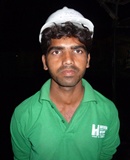 This Husk Power operator has been working for seven months. He lives locally and liked the idea of getting training. Before joining Husk Power, he was studying; he has a BA. In time he hopes to move on to become a mechanic and an engineer. ‘We never had electricity before and everyone is very happy,’ he says. ‘It’s very helpful for enabling children to study. And it’s good for shopkeepers and businessmen; they can work longer hours than before. And people can use computers because they have electricity.’
This Husk Power operator has been working for seven months. He lives locally and liked the idea of getting training. Before joining Husk Power, he was studying; he has a BA. In time he hopes to move on to become a mechanic and an engineer. ‘We never had electricity before and everyone is very happy,’ he says. ‘It’s very helpful for enabling children to study. And it’s good for shopkeepers and businessmen; they can work longer hours than before. And people can use computers because they have electricity.’
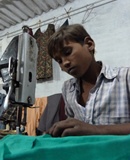 This boy works with his father running a family sewing business. They have had electricity for just one month. ‘We can work longer in the evenings, so I can make a little bit more,’ says his father. ‘And it’s easier to work at night because it’s quieter and cooler. Before we had a kerosene lamp and I had to stop working when daylight ended.’ Apart from the benefits of being able to work more, he says it gives him a happy feeling, he feels good, he has light.
This boy works with his father running a family sewing business. They have had electricity for just one month. ‘We can work longer in the evenings, so I can make a little bit more,’ says his father. ‘And it’s easier to work at night because it’s quieter and cooler. Before we had a kerosene lamp and I had to stop working when daylight ended.’ Apart from the benefits of being able to work more, he says it gives him a happy feeling, he feels good, he has light.
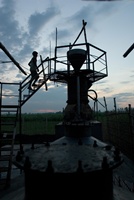 Husk Power Systems
Husk Power Systems
Husk Power Systems (HPS), based in Bihar, uses rice husks and other biomass waste to generate electricity. Started in 2007, it has now installed 65 mini-power plants (such as the one pictured), with another 10 in development as this issue of Alliance went to print. These plants power over 25,000 households in more than 250 villages and hamlets and affect the lives of approximately over 100,000 people in rural India. HPS currently has a staff of 350 spread out over 80 different locations. By 2014, HPS plans to have 2,014 plants installed, serving 5 million people or more.
HPS currently has three models:
- BOOM Built, owned, operated and maintained by HPS.
- BOM Built, owned and maintained by HPS, with the local partner, who operates the plants, putting up 10 per cent of project costs.
- BM Built and maintained by HPS, and HPS also gives training. The money is put up by the local partner, who owns and operates the plants.
The plan is that expansion will take place through the BM model, basically a franchising approach, as Gyanesh Pandey explains in his interview.
The sustainability of plants will depend on a number of different income streams:
- Selling electricity.
- Monetizing carbon and silica waste. HPS has tested six or seven products. At present they are focusing on making incense sticks. This is not the most lucrative option but it provides jobs for the local women who make them for HPS, as well as an income for HPS from selling them. Extracting silica is a more lucrative option that will be explored in the future.
- Channelling other products to customers.
- CDM benefits, ie carbon credits, but this is for the future.
For more information
http://www.huskpowersystems.com
Incense stick making
Caroline Hartnell
Making incense sticks is Husk Power’s first spin-off activity, using char waste from the process of power generation. It provides jobs for the local women who make them for Husk Power, as well as an income for Husk Power from selling them. Husk Power buys in the bamboo sticks and the women make them into incense sticks using the char and binder. The company that buys them will then add the extras like colour, perfume and packaging.
 The technique for making the incense sticks is still a work in progress – they still haven’t worked out how best to make sure they are evenly coated, Gyanesh Pandey told me – but they are already being made in considerable volume, as shown by the photo left of sticks drying in the sun and later packed into neat bundles. But there is no problem finding buyers – the Indian market for incense sticks is huge.
The technique for making the incense sticks is still a work in progress – they still haven’t worked out how best to make sure they are evenly coated, Gyanesh Pandey told me – but they are already being made in considerable volume, as shown by the photo left of sticks drying in the sun and later packed into neat bundles. But there is no problem finding buyers – the Indian market for incense sticks is huge.
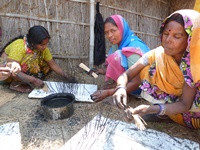 Afrina Katun (pictured) started making incense sticks five or six months ago. She makes about 2,000 rupees ($45) a month, which she says makes a big difference to her. ‘If it didn’t, I wouldn’t do it!’ she told me. For example, she can buy clothes for the children – previously she would have ‘waited forever for things like that’. Sometimes she can even buy medicines. There are ten people in her family, including six children. Learning to make the sticks does take time, she admits. ‘But if you don’t invest time, how will you learn?’
Afrina Katun (pictured) started making incense sticks five or six months ago. She makes about 2,000 rupees ($45) a month, which she says makes a big difference to her. ‘If it didn’t, I wouldn’t do it!’ she told me. For example, she can buy clothes for the children – previously she would have ‘waited forever for things like that’. Sometimes she can even buy medicines. There are ten people in her family, including six children. Learning to make the sticks does take time, she admits. ‘But if you don’t invest time, how will you learn?’

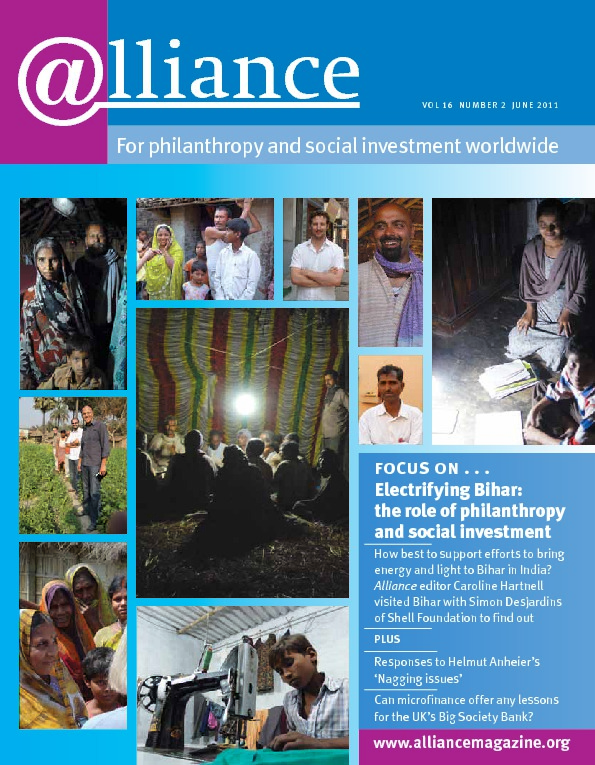


Comments (0)